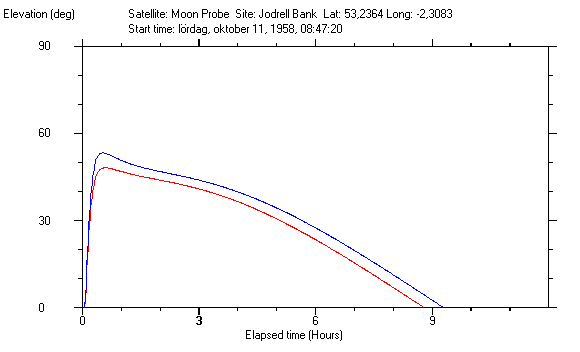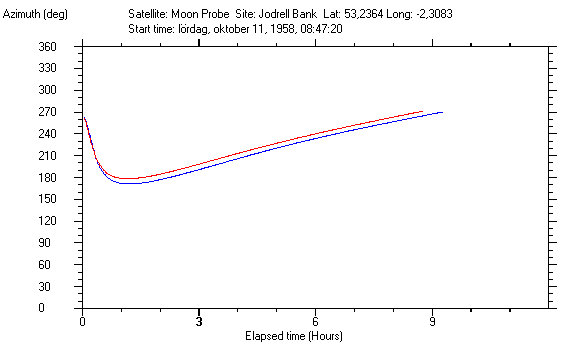Mission profiles of early U.S. lunar probes
Sven Grahn
Contents
At the end of 1957 and early
months of 1958 many persons and organizations in the U.S.A. were jockeying
for positions to get the task of answering the "Sputnik challenge". The
pressure from politicians in the U.S. executive branch and in Congress
on those responsible for missiles and space development to quickly come
up with significant space exploits was intense. The Air Force Ballistic
Missile Division in Los Angeles (with the Space Technology Laboratories
as their engineering organization) under Brigadier General Bernard Schriever
was one organization that thought it had the necessary know-how and clout
to do the job. The same was true for the U.S. Army Ballistic Missile Agency
under General Medaris and with Wernher von Braun in charge of its engineering
organisation in Huntsville, Alabama.
Thus, the White House announced
on 27 March 1958 that it had approved a program "to determine our capability
of exploring space in the vicinity of the moon and to obtain useful data
concerning the moon". The program was announced by Defense Secretary Neil
H McElroy. The Air Force Ballistic Missile Division in Los Angeles was
assigned a program of three lunar probes using a "Thor-Vanguard" system
with "a third stage to be developed". The Army Ballistic Missile Agency
in Huntsville, Alabama was authorized to "undertake one and possibly two
lunar probes" using modified Jupiter-C rockets. Overall responsibility
for the lunar probe launches was assigned to the Defense Department's Advanced
Research Projects Agency (ARPA).
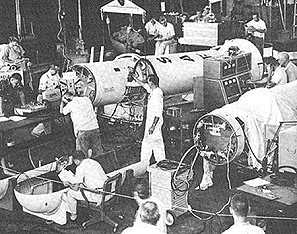 The Air Force project had its roots in the "Able project" which was probably
designed to provide a rocket that could test re-entry vehicle (RV)
technology for the ICBM that had not yet been flown successfully. To achieve
the speeds necessary to test a reasonably sized RV the USAF and its contractor
the Space Technology Labs used a Thor IRBM with the second stage of the
Vanguard as the upper stage (see picture on the right of second stages
being prepared). This combination was test flown three times in 1958, the
first time less than a month after the White House announcement and the
last less than a month before the first lunar probe attempt. (Launch
dates for the Thor-Able 0 rocket are: 23 April, 9 July and 23 July 1958).
The Air Force project had its roots in the "Able project" which was probably
designed to provide a rocket that could test re-entry vehicle (RV)
technology for the ICBM that had not yet been flown successfully. To achieve
the speeds necessary to test a reasonably sized RV the USAF and its contractor
the Space Technology Labs used a Thor IRBM with the second stage of the
Vanguard as the upper stage (see picture on the right of second stages
being prepared). This combination was test flown three times in 1958, the
first time less than a month after the White House announcement and the
last less than a month before the first lunar probe attempt. (Launch
dates for the Thor-Able 0 rocket are: 23 April, 9 July and 23 July 1958).
When NASA was formed in October of 1958, all military space
research projects run by the military organisations were transferred to it. This
included the four remaining flights in McElroy's (ARPA's) origonal plan and the
follow-on space probes planned by the USAF. This plan included a plan to launch
two probes (weighing 169 kg) to Venus in the launch window opening in June 1959
followed by a lunar orbit mission. However, after the Soviet success with Luna 1
the plans were changed to instead launch the follow-on provbes to lunar orbit in
the hope of beating the Soviet Union to this goal.
This follow-on Pioneer program
used the Atlas-Able rocket
and even before
the first flight the goal of photographing the far side of the Moon was snatched
by the Soviet union. Howevber, the first probe did carry a camera - it was too
late to change the plans. howveer, the two following oprobes did not carry a
camera, but instead more radiation monitoring instruments. However, the goal of
achieving lunar orbit before the Soviet union could still be
achieved.
List of launches
The two tables below list the
known launches in the first three U.S series of lunar probes. The first
table gives technical details, while the second givesa dates and flight
results as well as lunar coordinates.
| Name |
Dev
by |
P/L
mass |
L/V
|
Instrumentation |
Propulsion |
Electr. power |
RF
System
|
| Pioneer-0 |
STL |
38.1 |
Thor-Able |
TV camera,
radiation
detectors,
magnetometer |
Falcon motor for
lunar orbit injection
Verniers for trajectory
adjustment |
Batteries |
108.09 MHz, 50 W, TV
108.06 MHz, 0.3
W, TM
114.81375 MHz, TC |
| Pioneer-1 |
STL |
34.2 |
Thor-Able |
" |
" |
" |
108.09 MHz, 50 W, TV
108.06 MHz, 0.3 W,
TM
114.81375 MHz, TC |
| Pioneer-2 |
STL |
39.2 |
Thor-Able |
"
|
" |
" |
108.09 MHz, 50 W, TV
108.09 MHz, 0.1 W,
TM
108.06 MHz, 0.3 W, TM
114.81375 MHz, TC |
| Pioneer-3 |
JPL |
5.87
|
Juno-2 |
Radiation detectors
|
- |
" |
960.05 MHz TM
|
| Pioneer-4 |
JPL |
6.1 |
Juno-2 |
Radiation detectors |
- |
"
|
960.05 MHz TM |
|
P-3
|
STL |
168.7
|
Atlas-Able |
TV camera, magnetometers, radiation
detectors
| 2 hydrazine engines.
66 cm tank
in 1 m dia S/C. | 4 solar panels |
378.21 MHz TM 64 bps
401.85 MHz
TC
|
| P-30 |
STL |
175.5 |
Atlas-Able |
No TV camera |
" |
" |
378.21 MHz TM 64 bps
401.85 MHz TC |
|
P-31
|
STL |
175
|
Atlas-Able
|
No TV camera
|
" |
"
|
378.21 MHz TM 64 bps
401.85 MHz
TC
|
A lunar age
constraint?
 The
first three U.S. probes aimed at the Moon carried TV cameras to take pictures
of the Moon's far side and therefore the lunar age at arrival should be
be near zero, i.e. at New Moon. This means that the launch time should
be a few days before New Moon, i.e. at Lunar age near 27 days.. This is
indeed true for Pioneer-1 and -2, but not for Pioneer-0, the failed launch
attempt on 17 August 1958. Therefore another constraint must be taken into
consideration, namely the lunar declination at arrival. Since the launches
were carried out by a direct ascent to the translunar trajectory from a
site in the northern hemisphere the location of the moon had to be in the
southern part of the celestial sphere, i.e. the declination of the Moon
needed to be negative. (This is the same launch constraint as that of Soviet
lunar probes). When the Pioneer-3 probe was launched in December 1958 the
launch constraint was not not lunar age, but negative lunar declination.
However, during the late fall of 1958 the Moon was a t its lowest declination
near New Moon, so the launch of Pioneer-3 is very close to those of Pioneer-1
and -2 in the Age/launch time diagram below.
The
first three U.S. probes aimed at the Moon carried TV cameras to take pictures
of the Moon's far side and therefore the lunar age at arrival should be
be near zero, i.e. at New Moon. This means that the launch time should
be a few days before New Moon, i.e. at Lunar age near 27 days.. This is
indeed true for Pioneer-1 and -2, but not for Pioneer-0, the failed launch
attempt on 17 August 1958. Therefore another constraint must be taken into
consideration, namely the lunar declination at arrival. Since the launches
were carried out by a direct ascent to the translunar trajectory from a
site in the northern hemisphere the location of the moon had to be in the
southern part of the celestial sphere, i.e. the declination of the Moon
needed to be negative. (This is the same launch constraint as that of Soviet
lunar probes). When the Pioneer-3 probe was launched in December 1958 the
launch constraint was not not lunar age, but negative lunar declination.
However, during the late fall of 1958 the Moon was a t its lowest declination
near New Moon, so the launch of Pioneer-3 is very close to those of Pioneer-1
and -2 in the Age/launch time diagram below.
The P-3 probe launch in November
1959 again carried a TV camera for taking pictures of the Moon and the
lunar age at its launch was very close to that of Pioneer-2. In the fall
of 1960 when the P-30 and P-31 probes were launched the Moon was again
near its lowest declination close to New Moon.All these factors have led
to, by pure co-incidence that the early U.S. launches to the Moon are much
more clumped together in the lanuch Time/age diagram that the Soviet launches
to the Moon in the same period.The arrival times are based on a flight time for Pioneer 0-2
to the Moon of (57.5 hours until retro-firing) 62 hours to lunar orbit. The
planned flight time to the Moon for Pioneer-3 and -4 was 34 hours. It seems that
the flight time for the Atlas-Able probes was also 62 hours (
1).
| Name |
Date |
Time
(UT)
|
AGE
at launch
|
L/V |
Notes |
Planned
arrival time
|
Age, Decl.Phase
at arrival
|
Decl. at
arrival |
| Pioneer-0 |
17 Aug 1958 |
1218
|
2.7
|
Thor-Able |
Exploded at T+77 sec |
20 Aug 0218 UT |
5.6, 212
|
-12.14 |
| Pioneer-1 |
11 Oct 1958 |
0842
|
27.8
|
Thor-Able |
Too low speed. Hmax=110
000 km |
13 Oct 2300 UT |
1.3, 214
|
-12.32 |
| Pioneer-2 |
8 Nov 1958 |
0731
|
26.1
|
Thor-Able |
Third stage did not ignite |
10 Nov 2130 UT |
29.1, 221
|
-13.85 |
| Pioneer-3 |
6 Dec 1958 |
0545
|
24.5
|
Juno-2 |
Too low speed. Hmax=102
000 km |
7 Dec 1545 UT |
26.1, 211
|
-11.32 |
| Pioneer-4 |
3 Mar 1959 |
0511
|
23.3
|
Juno-2 |
Missed Moon with 60 000
km |
4 Mar 1511 UT |
24.8, 286
|
-17.37 |
| P-3 |
26 Nov 1959 |
0726
|
24.9
|
Atlas-Able |
Shroud splits at T+70 sec. |
28 Nov 2126 UT |
27.9, 224
|
-13.05 |
| P-30 |
25 Sep 1960 |
1513
|
4.8
|
Atlas-Able |
Second stage fails to ignite |
28 Sep 0513 UT |
7.6, 278
|
-18.47 |
| P-31 |
15 Dec 1960 |
0840
|
26.1
|
Atlas-Able |
Explodes shortly after launch. |
18 Dec 2240 UT |
0.5, 274
|
-18.63 |
The flight time must be either
0.5, 1.5 or 2.5 days to permit viewing of the lunar approach from the United
States, in particular from the Goldstone station in California. A flight
time to the Moon of only 0.5 days would require a very high energy trajectory
with an injection velocity of 13.7 km/s, clearly an impossible figure!
Therefore the shortest flight time to the Moon was 1.5 days, which was
what was intended for Pioneer-3 and -4. All other probes aimed at 2.5 days
flights time, i.e a period of about 60 hours.
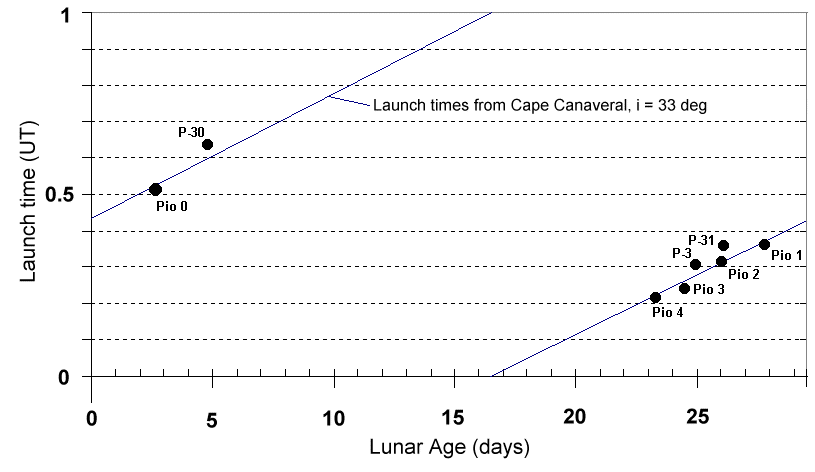
A lunar declination constraint?
Just as for the early Soviet lunar probes the declination of
the Moon at arrival was always negative. We can use the declination phase
plotting method developed by Richard S Flagg (See
"Mission profiles of 7K-L1 flights"
) and plot the early Pioneer missions in the declination phase/Age
diagram. From the figure below it is again evident that the declination of the
Moon for all launch attempts were negative! (This diagram shows the
age/declination phase at arrival). This is a direct consequence of having the
launch site in the northern hemisphere and using a direct ascent. It was simply
not possible to reach the Moon at declinations above the celestial equator
without resorting to the parking orbit technique of later
flights.
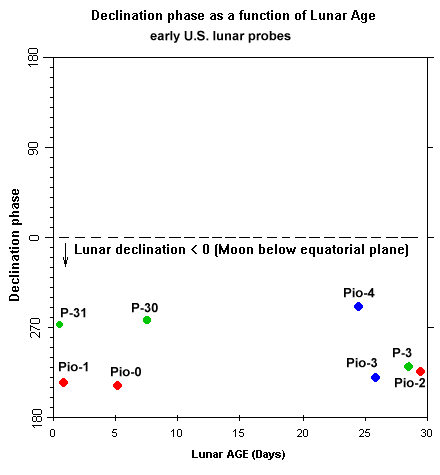
Trajectory data for Pioneer-1
and the actual and intended flight
path.
The values in the table below contain values from (2 ) converted to metric units.
|
Actual injection
conditions for Pioneer-1 |
| Flight
phase |
Parameter |
Value |
| Launch |
Time |
0842:13 UT, 11 October
1958 |
| Burnout |
|
|
| |
Time |
0847:20 UT, 11 October
1958 |
| |
Altitude |
430.05 km |
| |
Latitude |
30.7° N
|
| |
Longitude |
71.07° W |
| |
Velocity
magnitude |
10.5230676
km/s |
| |
Velocity
azimuth |
70.43° |
| |
Velocity angle from vertical |
64.74° |
| Apogee |
Altitude |
113784 km |
| Re-entry |
Time from lifr-off |
43 hours 17.5 minutes |
| |
Latitude |
21.0° S |
| |
Longitude |
88.1° W |
The velocity vector for Pioneer-1 was 5 degrees from the intended
azimuth. Therefore the intended azimuth is set at 75.43 degrees. The speed at injection for the intended
flight path is not so easy to determine exactly from (2
). There are several values given as you can see
from this table:
|
Various intended
injection conditions for Pioneer-1 derived from
(2) |
| Speed given at |
V = speed at injection
|
h = altitude at injection
|
Total energy
(km2/s2) |
| Page 4 |
35216 fps (10.73384 km/s) |
224 n.m (415.07
km) |
-1.068813 |
| Page 57 |
35400 fps (10.78992 km/s) |
200 st.m (321.8
km) |
-1.282107 |
| Page 83 |
35206 fps (10.73079 km/s) |
1410 k.ft (430.05
km) |
-0.972437 |
Page 4=v
(Page 76=h) |
35216 fps (10.73384 km/s) |
1410 k.ft
(415.07 km) |
-0.939725 |
By using the actual injection
parameters the orbital elements and other characteristics of Pioneer-1 can be calculated (see table
below) by using classical Keplerian mechanics (3). By using the last line in the table
above the orbital elements and other characteristics of the intended trajectory
of Pioneer-1 can be calculated in the same way. The reason for
ignoring the velocity given on page 83 is that I think it is a misprint. The
actual speed should be as given on page 4 - in my opinion. The apogee and period
of the calculated orbit for the actual injection conditions match the data in
(2
) reasonably well. The apogee of
the orbit resulting from the intended injection conditions also looks reasonable. The
negative perigee is caused by the steep flight path angle at
injection.
|
Computed orbital
elements |
| Orbital element
etc.. |
Actual |
Planned |
| Apogee (km) |
113477 |
412332 |
| Perigee (km) |
-874 |
-832 |
| Inclination (°) |
35.79 |
33.56 |
| RAAN (°) |
25.28 |
17.41 |
| Argument of Perigee (°) |
7.90 |
15.88 |
| Angle from node (°) |
60.3 |
66.8 |
| True anomaly (°) |
53.15 |
51.27 |
| Mean anomaly (°) |
1.2 |
0.2 |
| Time from perigee (min) |
8.4 |
8.0 |
| Time perigee-to-apogee (hrs) |
21.7 |
135.0 |
| Period |
43 h 24 m |
11 d 6 h 5
m |
| Declination of apse line (°) |
-4.2 |
-8.54 |
| Sun aspect angle at injection (°) |
52.3 |
51.5 |
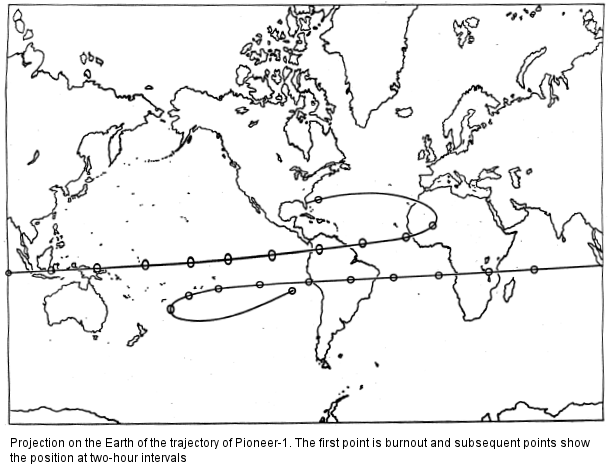
The map above comes
from (2). The map below was generated by my own orbit analysis software SMX using the
orbital elements derived from the actual injection condition. Time is shown at the
same interval as in the map above. The radio horizon for the tracking station on
the island of Hawaii is shown (yellow dot). The two graphs are reasonably
similar.
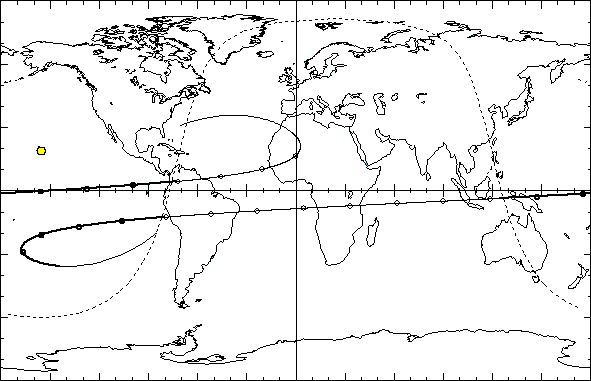
The map below shows the ground track during the first 12
hours for the
actual mission and the intended mission. The thicker track marks
the part of the flight when the probe is above the
horizon at Jodrell Bank (marked yellow). The other sites (Cape Canaveral, Singapore, Millstone Hill)
are shown as green dots. One can clearly see the diffence
in flight azimuth.
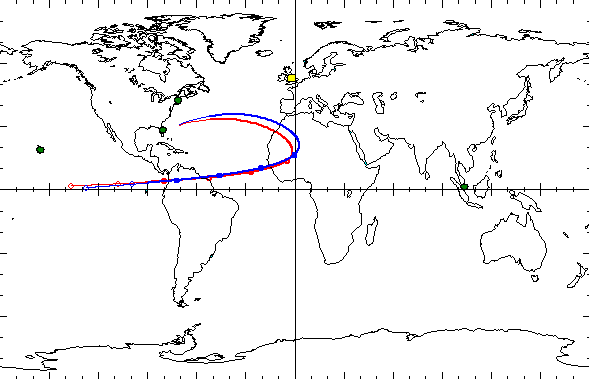
The two ground tracks quickly deviate from each other, but how soon
was this evident as seem from the tracking station?The two graphs below show
elevation and azimuth of the actual and intended mission as seen from Jodrell Bank.
Clearly, by the time the probe rose above the horizon at Jodrell Bank the
elevation angle was almost 5 degrees too low and it must have been obvious
that the probe would not reach the Moon.
One can compare the blue graphs with the figure below from (2). The
agreement is reasonably good.
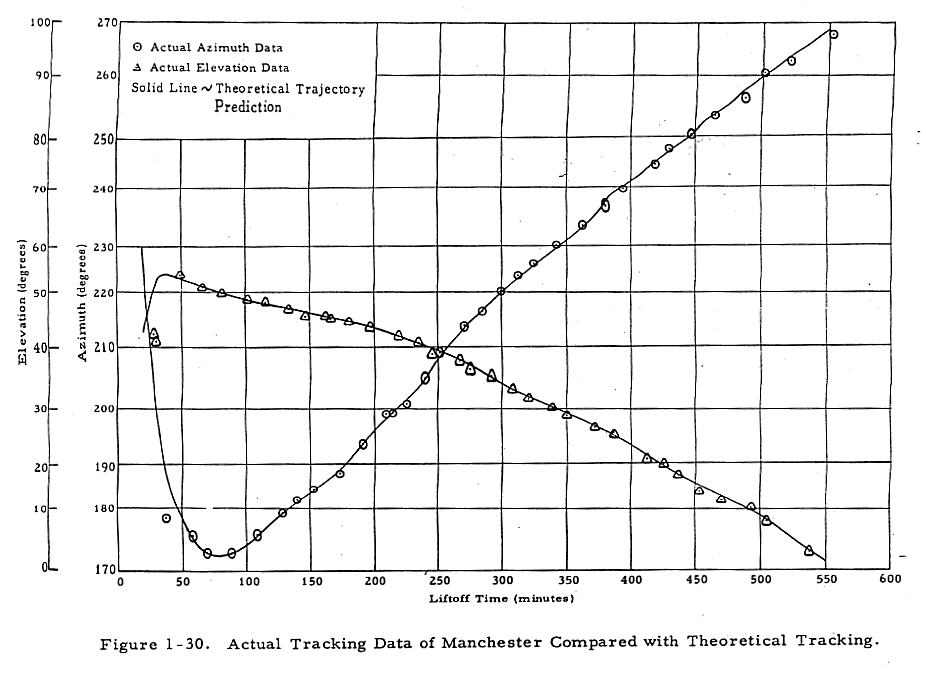
I have tried to
compute the motion of the probe relative to the Moon in the case of disregarding
the gravititaional effects of the Moon in order to try to see what a "patched-conic" analysis might bring. When
the probe reached about 65000 km from the Moon about 55 hours after launch its
speed relative velocity was 1.27 km/s and it possessed a total energy
of 0,73 km2/s2 relative to
the Moon. To obtain capture the spped would have to be reduced by 0.88 km/s. In
(2) it is stated that the probe's
retrorocket had a delta-v capability of 0.85 km/s - about the same! So, the
computed trajectory is probably not so far from what was actually intended. One
parameter that may be changed to obtain a more plausible trajectory is the
injection azimuth. It could possibly be a little higher than the 75.4 degrees
used in this analysis. Pioneer-2 flew at an azimuth of 77.0
degrees. Anyway, the graph below shows the motion of the Moon and the
computed intended trajectory and
the computed actual trajectory.
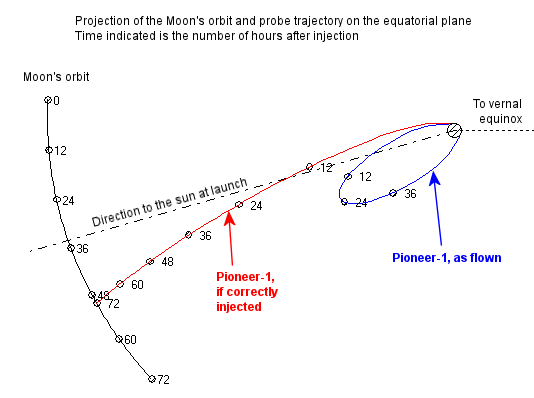
References
- Swedish
evening paper Aftonbladet, Thurday, 26 November 1959
- 1958 NASA/USAF space probes
(Able-1), Final report, Vol. 1, Summary, Space Technology Laboratories, 16
February 1959.
- R
Bate, D Mueller, J White, "Fundamentals of astrodynamics", Dover Publications,
New York, 1971.

 Back
to "Space History Notes"
Back
to "Space History Notes"
 The Air Force project had its roots in the "Able project" which was probably
designed to provide a rocket that could test re-entry vehicle (RV)
technology for the ICBM that had not yet been flown successfully. To achieve
the speeds necessary to test a reasonably sized RV the USAF and its contractor
the Space Technology Labs used a Thor IRBM with the second stage of the
Vanguard as the upper stage (see picture on the right of second stages
being prepared). This combination was test flown three times in 1958, the
first time less than a month after the White House announcement and the
last less than a month before the first lunar probe attempt. (Launch
dates for the Thor-Able 0 rocket are: 23 April, 9 July and 23 July 1958).
The Air Force project had its roots in the "Able project" which was probably
designed to provide a rocket that could test re-entry vehicle (RV)
technology for the ICBM that had not yet been flown successfully. To achieve
the speeds necessary to test a reasonably sized RV the USAF and its contractor
the Space Technology Labs used a Thor IRBM with the second stage of the
Vanguard as the upper stage (see picture on the right of second stages
being prepared). This combination was test flown three times in 1958, the
first time less than a month after the White House announcement and the
last less than a month before the first lunar probe attempt. (Launch
dates for the Thor-Able 0 rocket are: 23 April, 9 July and 23 July 1958).
 The
first three U.S. probes aimed at the Moon carried TV cameras to take pictures
of the Moon's far side and therefore the lunar age at arrival should be
be near zero, i.e. at New Moon. This means that the launch time should
be a few days before New Moon, i.e. at Lunar age near 27 days.. This is
indeed true for Pioneer-1 and -2, but not for Pioneer-0, the failed launch
attempt on 17 August 1958. Therefore another constraint must be taken into
consideration, namely the lunar declination at arrival. Since the launches
were carried out by a direct ascent to the translunar trajectory from a
site in the northern hemisphere the location of the moon had to be in the
southern part of the celestial sphere, i.e. the declination of the Moon
needed to be negative. (This is the same launch constraint as that of Soviet
lunar probes). When the Pioneer-3 probe was launched in December 1958 the
launch constraint was not not lunar age, but negative lunar declination.
However, during the late fall of 1958 the Moon was a t its lowest declination
near New Moon, so the launch of Pioneer-3 is very close to those of Pioneer-1
and -2 in the Age/launch time diagram below.
The
first three U.S. probes aimed at the Moon carried TV cameras to take pictures
of the Moon's far side and therefore the lunar age at arrival should be
be near zero, i.e. at New Moon. This means that the launch time should
be a few days before New Moon, i.e. at Lunar age near 27 days.. This is
indeed true for Pioneer-1 and -2, but not for Pioneer-0, the failed launch
attempt on 17 August 1958. Therefore another constraint must be taken into
consideration, namely the lunar declination at arrival. Since the launches
were carried out by a direct ascent to the translunar trajectory from a
site in the northern hemisphere the location of the moon had to be in the
southern part of the celestial sphere, i.e. the declination of the Moon
needed to be negative. (This is the same launch constraint as that of Soviet
lunar probes). When the Pioneer-3 probe was launched in December 1958 the
launch constraint was not not lunar age, but negative lunar declination.
However, during the late fall of 1958 the Moon was a t its lowest declination
near New Moon, so the launch of Pioneer-3 is very close to those of Pioneer-1
and -2 in the Age/launch time diagram below.




